The Emerald Ash Borer

INTRODUCTION
Agrilus planipennis commonly called the Emerald Ash Borer (EAB) due to the emerald green color of the adult beetle, and its life cycle which involves the boring into and out of ash trees (Fraxinus sp.). EAB was first discovered in Michigan in 2002, but is believed to have established a breeding population within the United States by 1990. Though no specific introduction site or vector it is believed that the EAB was introduced by commercial packing material by boat or plane. Today, EAB is found commonly throughout 35 states/provinces of the U.S. and Canada. Since its establishment and spread EAB has been responsible for the deaths of millions of ash trees and to a lesser extent the fringed trees. In response the U.S. and Canada are committed to stopping spread, managing infested areas, and maintaining healthy ash populations.
LIFECYCLE
The EAB life cycle is similar to that of many insects with individuals transitioning from egg, larva, pupa, to adults. Below find a video demonstrating the life cycle of the EAB.

Eggs:
EAB lays its eggs from June to August directly onto the bark of ash trees. The yellowish gray in color, the egg are laid one at a time and EAB adults will lay between 50-100 eggs a year. The eggs are about 1-mm circles and take 1-2 weeks to incubate.
Larva:
The larva that emerges from EAB eggs bores into the tree where it will spend 1-2 years feeding on the ash tree tissue. Larva feed in an S-shaped pattern called galleries, and reach about 1-1.5 inches in length. Once large enough larva with borer deep into the tree to mature into Pupa. The larval stage is the most destructive to ash tress.
Pupa/Adult:
Pupating over winter in the sapwood of ash trees, the EAB adult emerges in spring by boring out of the tree leaving a distinguishable D-shaped exit hole. Adults which are a metallic emerald green are about a half-inch long, and feed on ash leaves. Adults do very little damage to ash trees as they feed.
IMPACTS
The EAB has spread rapidly to over 35 states and provinces of the U.S. and Canada. The EAB invasion of north america has resulted in the deaths of millions of ash trees impacting the economy and environment.
Biologically, the ash tree is an important part of the tree community that inhabits wetland and flood lane areas. The death of trees can make a forest community more susceptible to the introduction of other invasive plants and animals. Structurally, the loss of ash trees can intensify wind damage, increase erosion, and create habitat fragmentation.
RESPONSE
Combating and managing EAB at the state level or even at the individual level is very similar. You must identify, isolate, and treat/manage the infestation.
Identification:
The first and very important step in EAB management is accurate and early identification. EAB treatment is costly and is more successful when used on healthy trees, so early identification is necessary. Here is how you can identify EAB tree infestation.
Isolation:
Once identified, isolating the problem helps reduce the spread and cost of treatment. Isolation on a small scale may include removal and destruction of trees determined not to be healthy enough for treatment. Complete removal and destruction is key. Wood should not be stored as EAB can survive and harvested wood and removal should seek to limit the transportation because transportation can spread the EAB. On a larger scale salvaging harvest of infected trees is possible. Its important not to transport wood of anytime as this may help spread invasives including the EAB.
Treatment:
The main form of treatment is through use of pesticide as displayed in the video below. Pesticide treatment programs created by professionals monitor and treat infested trees as well as prevent infestation on healthy trees.



Comments
Post a Comment